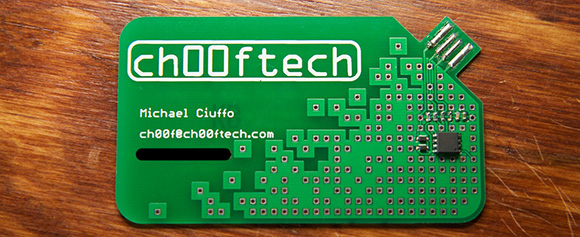[ch00f] is at it again, expanding the horizons of the art of PCB business cards. This one draws his logo on any computer over a USB port.
The physical design of the card is heavily inspired by [Frank Zhao]’s card; both use an ATtiny85 and the V-USB package to handle the USB protocol and communications. Instead of typing words into a text editor like [Frank]’s, [ch00f]’s card draws the ch00ftech logo in MS Paint or other image editor.
There was a problem with simply emulating the mouse to draw a logo on the screen, though; because different computers have different mouse settings for acceleration, the ch00ftech logo was nearly always distorted. [ch00f] fixed that by emulating an absolute input device, basically turning his business card into a single-function pen tablet.
The logo was traced by hand and put into a few arrays in the firmware. Surprisingly, the logo didn’t take up much space – only 4k of the tiny85’s flash is used. There’s a lot more space for a more complicated drawing, but for now the simple ch00ftech logo (video after the break) will do.
[youtube=http://www.youtube.com/watch?v=lF31aDuSZ6E&w=580]
















Cool, but a bit oldschool. I prefer NFC business cards
i used to have them … there only useful i found when having a frined take your cell info … i now keep just one in my wallet just so people can scan my wallet
i personally prefer ones with QR codes (simple but shockingly effective seeing how few people i have to give them to have/use NFC) and there cheap to make a bunch
but i would love a few USB ones like this or similar for the few clients making it work my while!
The problem with QR codes is you just never know where they’re going to take you.
https://lh3.googleusercontent.com/-gOyUkGvd3ps/TM92Uqa9tAI/AAAAAAAABAs/7UPgeIb51D0/s280/img.php.png
“The problem with QR codes is you just never know where they’re going to take you.”
Totally unlike a USB stick from a stranger. I have my QR reader set up to show the link first. I think I’d rather take my chances with getting a paper cut from an old school business card than use this. BTW, I can’t remember the last time I opened Paint.
It would be cool if it did something related to his business.
Sorry if my comment sounded like it was putting down his project. It’s cool he figured out how to replicate the image that way.
yeah if your QR scanner goes right to the site somthing is wrong with your QR scanner XD
and paint is the #1 tool for taking screenshots! probably why Microsoft 15 years later still make print screen just copy to the clipboard ..
Last I heard the number of people with QR readers installed continues to be very low.
Plus you aren’t going to impress anybody with a QR-code of course, it’s practical maybe – but not exciting.
You never know if the URL you’re typing in from a card is a redirect to lemonparty either.
But wile typing you have time to think if the person you got the card from is someone you might want to not trust.
i love this guys work!
AHH another really cool design today! ^ I agree, love this work.
I wonder if how he gives a written offer for the source code or the source itself along with the card… since it’s using V-USB and that’s GPL.
The back of the card has a URL that links to this page: http://ch00ftech.com/card which contains a link to the page containing the source code.
I couldn’t find a link to the code (all of it)… I’ll try to make my point clearer: the GPL enforces you to offer all the code (not just V-USB) to anyone receiving a copy of the binaries (ie, anyone you give the card to). The code could be embedded in the hardware itself or you should give a written offer to the source code along with the card.
I’m just being a stiff about GPL, I understand that a written offer totally kills the “cool” part of the business card… but I just wanted to know if you had thought about solving that part too.
http://ch00ftech.com/wp-content/uploads/2013/03/Business-Card-v2.0.zip
From: http://ch00ftech.com/2013/03/25/making-a-cooler-business-card/
Since you have not received your copy of his business card I find your lack of faith deeply disturbing.
A relative of mine works for a company that makes business cards where a thicker piece, on the bottom edge, snaps off. It’s the same thickness as a USB plug. So you slide it in a USB port, and it’s a useful flash drive, I think a couple of GB.
Unfortunately it looks like, after that, you’d just throw away the main card piece, so kinda pointless. Though the remaining flash drive can still have your website and phone number printed on it.
V-USB requires a faster clock than the Tiny85 has, doesn’t it?
Perhaps you use the OSCCAL to crank it up?
from the wiki:
V-USB can currently handle clock rates of 12 MHz, 12.8 MHz, 15 MHz, 16 MHz, 16.5 MHz, 18 MHz and 20 MHz. These clock rates are precise! A crystal with 11.9 MHz won’t work! Only the 16.5 MHz and 12.8 MHz variants allow a deviation of up to 1%. They are therefore suitable for RC oscillators. 16.5 MHz is suitable for devices which can derive a 16 MHz clock from an RC oscillator (e.g. ATTiny25/45/85 and ATTiny26), 12.8 MHz can usually be reached by calibrating the 8 MHz RC oscillator. Calibration of the RC oscilator is described at examples.
I’ve used v-usb on several Attiny45/85 using the built-in RC oscillator and it works like a charm :)
Love it Cuiffo!
Nice and all, but how did he install Windows 7 on MacBook Pro?
Boot Camp